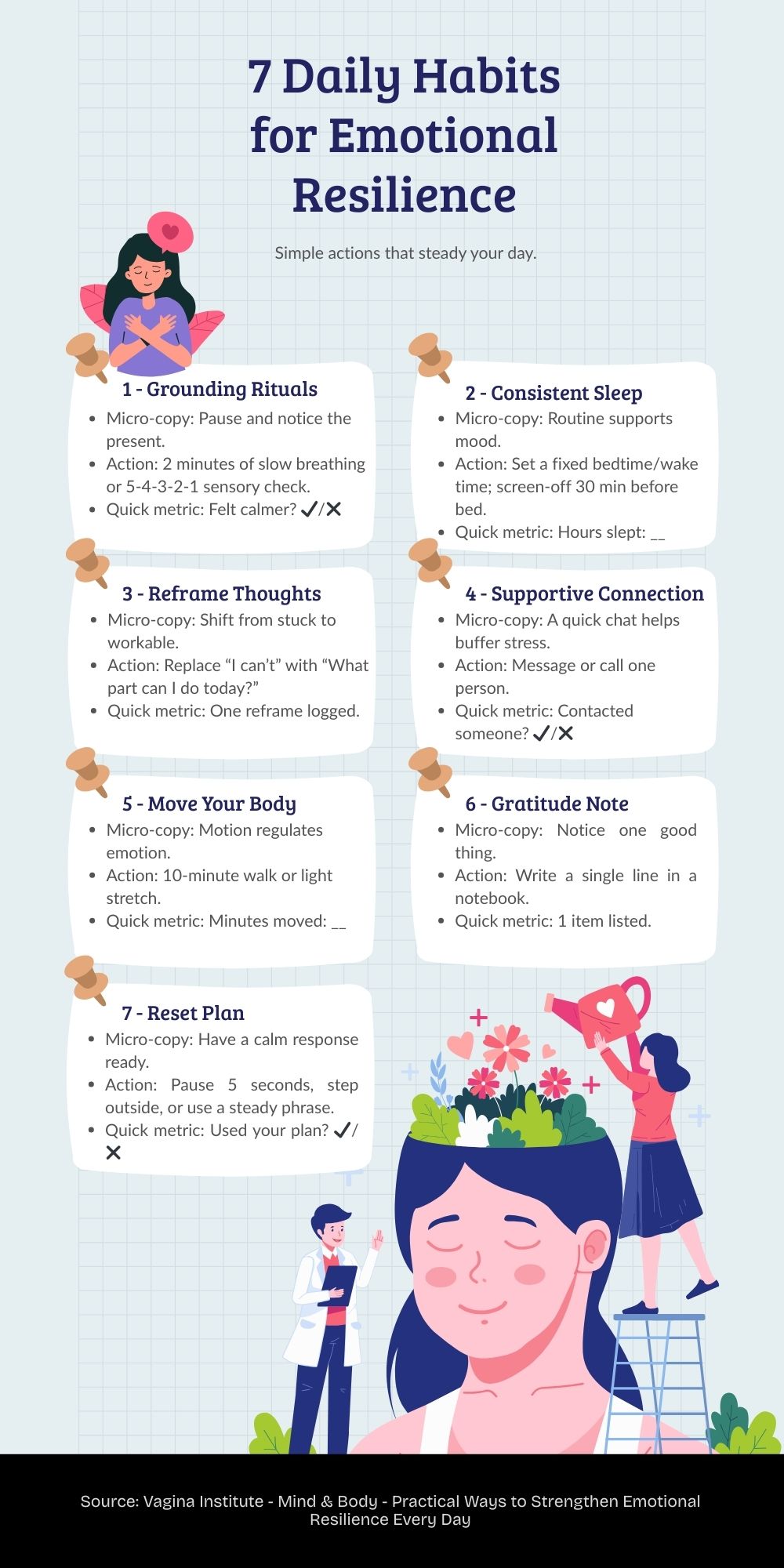Practical Ways to Strengthen Emotional Resilience Every Day

Life can bring unexpected challenges, and how we respond often depends on our emotional resilience—the ability to adapt and recover from stress, setbacks, and uncertainty. Emotional resilience isn’t about ignoring feelings or pretending everything is fine. Instead, it’s about building habits that help you manage stress in a healthy way and regain balance when life feels overwhelming.
This guide outlines practical, science-backed strategies you can use daily to strengthen your emotional resilience without overcomplicating your routine.
| Habit | Purpose |
|---|---|
| Grounding Rituals | Reduce stress and calm the mind |
| Consistent Sleep | Supports emotional stability |
| Reframe Negative Thoughts | Build a solution-focused mindset |
| Social Connection | Strengthens emotional support |
| Movement | Regulates mood and energy |
| Gratitude Practice | Improves mood over time |
| Reset Strategies | Quick stress relief during crises |
1. Start with Small Grounding Rituals
When stress levels rise, the mind can race and amplify worries. Grounding rituals—simple actions that bring you into the present—can help. Examples include:
-
Morning breathing exercise: Spend two minutes focusing on slow, deep breaths before checking your phone.
-
Sensory reset: Notice five things you can see, four things you can touch, three things you can hear, two you can smell, and one you can taste.
These practices signal safety to your nervous system, reducing stress responses.
2. Build a Consistent Sleep Pattern
Sleep plays a major role in emotional stability. Research shows that lack of sleep makes people more reactive to stress and less able to regulate emotions.
-
Aim for 7–9 hours of quality sleep.
-
Keep a consistent bedtime and wake-up schedule, even on weekends.
-
Reduce screen time at least 30 minutes before bed to help your mind wind down.
3. Reframe Negative Thoughts
Resilience isn’t about being overly positive—it’s about perspective. When negative thoughts take over, try cognitive reframing:
-
Instead of “This is impossible,” ask, “What part of this can I handle today?”
-
Instead of “I can’t do this,” reframe to “I haven’t figured it out yet.”
This small shift helps reduce mental roadblocks and keeps your mind solution-oriented.
4. Strengthen Supportive Connections
Humans are wired for connection, and social support can act as a buffer against stress.
-
Reach out to a friend, family member, or colleague for a quick chat.
-
Share how you’re feeling without expecting advice—sometimes listening is enough.
-
If in-person interaction is limited, schedule virtual check-ins or join a community group that shares your interests.
5. Move Your Body Regularly
Physical activity isn’t just for fitness—it helps regulate mood and stress hormones. You don’t need a full workout every day; even small actions make a difference:
-
A 10-minute walk after lunch.
-
Light stretching before bed.
-
Dancing to a favorite song while making coffee.
6. Practice Micro-Moments of Gratitude
Gratitude isn’t about forcing positivity; it’s about noticing what’s good, even in small ways.
-
At the end of the day, write down one thing that went well or felt good.
-
Acknowledge small wins: finishing a task, enjoying a meal, or having a calm moment.
Over time, this habit can improve overall mood and outlook.
7. Create a Reset Strategy for High-Stress Moments
Stressful situations are inevitable. Having a go-to response can keep you from feeling overwhelmed. Examples:
-
Pause before reacting: Count to five before speaking or sending that email.
-
Step outside for fresh air: Even two minutes outdoors can shift perspective.
-
Repeat a calming phrase: Something like, “I can handle this one step at a time.”
Final Thoughts
Building emotional resilience is a gradual process, not an overnight change. These small, consistent habits—grounding, sleep, reframing thoughts, connection, movement, gratitude, and reset strategies—can create a foundation for handling life’s challenges with steadiness and clarity.

Disclaimer: The articles and information provided by the Vagina Institute are for informational and educational purposes only. This content is not intended to be a substitute for professional medical advice, diagnosis, or treatment. Always seek the advice of your physician or another qualified health provider with any questions you may have regarding a medical condition.


 English
English  Deutsch
Deutsch  Español
Español  Français
Français 


